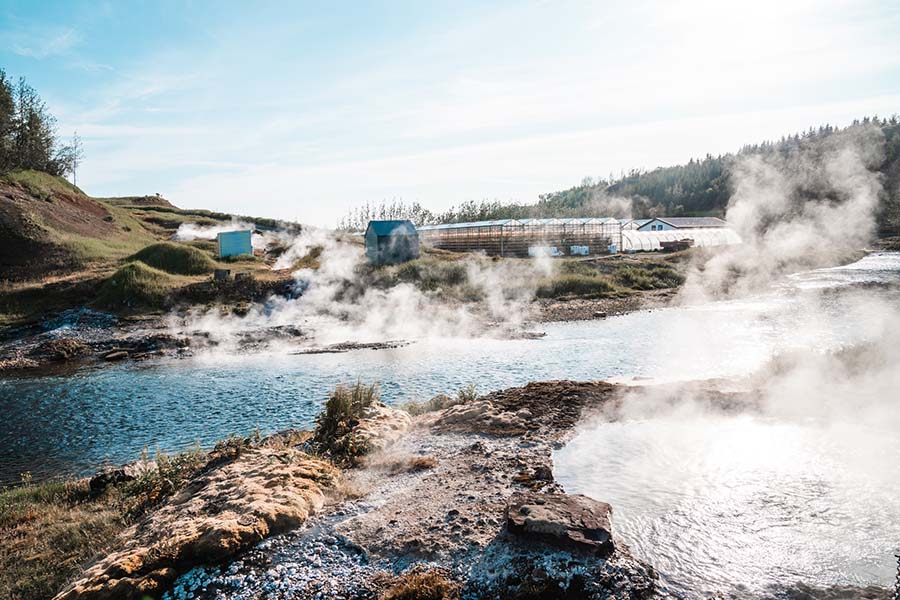Now that we’ve established geothermal’s challenges and opportunities, we can examine the science that makes these greenhouses possible. Since understanding how geothermal energy works is the first step toward designing a successful system, this chapter will explain the basic principles of the Earth’s natural heat and then introduce the two core technologies that have been developed to harness it for year-round growing.
Harnessing the Earth’s Heat: Two Distinct Sources
The ground beneath our feet is warmed by two different sources: immense heat radiating up from the Earth’s core and mantle, and a vast amount of solar energy absorbed at the surface. All geothermal systems tap into this warmth, but the energy source determines which technology is used. The simplest way to remember the distinction is this: deep geothermal seeks out rare pockets of high heat from the planet’s core, while shallow geothermal uses the moderate, stable temperature of the ground that’s available right in your own backyard.
Deep Geothermal: Tapping the Planet’s Furnace
Heat from the Earth’s core and mantle is immensely powerful and intense, but it dissipates as it travels outwards through miles of the Earth’s crust. Since drilling dozens of miles deep isn’t practical, deep geothermal power plants are exclusively located in “hot spots” where the crust is relatively thin and heat is much closer to the surface, typically 1-3 miles deep. These systems, sometimes called hydrothermal, tap directly into natural underground reservoirs of very hot water or steam.
To understand where deep geothermal is viable, you need to look at a map of the Earth’s tectonic plates. The Pacific Ring of Fire, for example, is a massive arc of intense volcanic and seismic activity where the crust is often thinner and more fractured. This is why countries all along the Ring of Fire—from Indonesia and the Philippines to New Zealand and Mexico—are leaders in this technology. These geological “hot spots” provide the powerful, high-grade heat necessary for large-scale direct use and electricity generation.
Shallow Geothermal: The Earth as a Solar Battery
Over most of the planet, where the intense heat of the mantle stays comfortably deep, the top layers of the crust are primarily warmed by the radiant heat of the sun. With the exception of regions with permafrost, the top few hundred feet of ground absorb and store the sun’s energy like a massive thermal battery. The soil itself acts as an insulating layer, so a few feet below the surface, daily and seasonal temperature fluctuations average out, creating a zone with a remarkably stable temperature year-round, typically between 45°F and 75°F.
Shallow geothermal relies on geo-exchange technology, where a system of buried pipes circulates fluid through this stable temperature zone, absorbing the ground’s stored warmth to heat a greenhouse. Because it relies on this stored solar energy, this type of system can be built pretty much anywhere, and its application in some unexpected places highlights its versatility.
- In a cold-climate country like Sweden, for instance, hundreds of thousands of homes and buildings are heated using ground-source heat pumps, making it a world leader in the technology’s adoption.
- On an institutional scale, Ball State University in Indiana replaced its coal-fired boilers with one of the largest geo-exchange systems in the United States, using the stable temperature of the Earth to heat and cool its entire campus.
For a specific project, the main geological factor is the thermal conductivity of your soil. Less favorable soil may require a larger system to achieve the same results.
A Closer Look at Soil and Thermal Conductivity
The key ingredients for good thermal conductivity are soil density and moisture. As we’ve all experienced, water is a much better conductor of heat than air, so wet, dense soils are far superior to dry, loose soils.
While a professional geothermal installer will perform a detailed analysis, here is a general ranking of common soil types from best to worst for thermal conductivity:
- Excellent: Saturated sand or gravel. The high water content and good contact between particles make for a very efficient heat transfer medium.
- Good: Dense, moist clay or silt. These soils hold moisture well and provide good conductivity.
- Poor: Dry, loose sand or gravel. The air pockets between the dry particles act as an insulator, dramatically reducing heat transfer.
- Very Poor: Solid bedrock. Dense, solid rock can be a poor conductor and is very expensive to drill through, making it a challenging substrate for geo-exchange systems.
Doing Your Homework: Where to Find Local Data
This is where you can do some practical research to understand the potential of your specific location.
Start with the Soil Survey
The single most powerful tool for a landowner in the United States is the USDA’s Web Soil Survey. This free online tool, operated by the Natural Resources Conservation Service (NRCS), provides detailed data on soil types, characteristics, and limitations for various uses for over 95% of the nation’s private lands. You can use it to determine your soil composition, depth to bedrock, and other crucial factors.
Consult Geological Maps
For a broader view, the U.S. Geological Survey (USGS) provides extensive maps and data that can help you understand the general geology of your region, which can be useful for larger projects.
Talk to the Real Experts
The most valuable information will come from local professionals. Contact certified geo-exchange installers and local well drillers. These are the people with years of on-the-ground experience who know exactly what the conditions are like ten, fifty, or one hundred feet below your feet.
Looking Ahead
Now that we’ve reviewed the two fundamental types of geothermal energy—rare, powerful heat from deep geothermal “hot spots” and universally available, moderate warmth from shallow geothermal systems, the next obvious question becomes: how do you get that heat from the ground into a greenhouse? What do these systems actually look like, and what are their specific pros and cons? The next two chapters look at each technology in detail, breaking down the components, design considerations, and real-world applications to help you understand which path might be right for your project.




